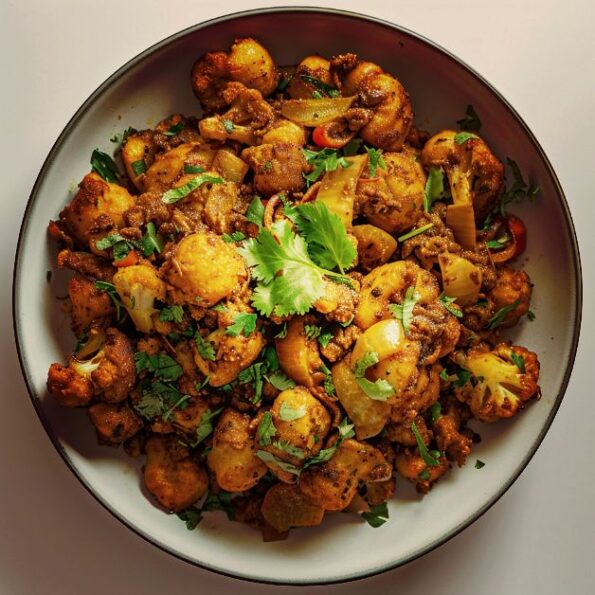Aloo Gobi Masala Restaurant Style (Potatoes and Cauliflower)

About Aloo Gobi Masala
Aloo Gobi Sabji or masala is a popular Indian dish for its simplicity and rich flavor. The name "Aloo Gobi" comes from Hindi, where "aloo" means potatoes and "gobi" means cauliflower. This dish combines these two vegetables with a blend of spices to create a tasty and aromatic meal.
My version of aloo gobi masala can fit into any busy schedule as it is one of my convenient side dishes for my lunch boxes. This aloo gobi masala recipe tastes exactly like restaurant style, as I learned from a small hut restaurant near my office where most of my lunch is either pulkha /aloo gobi masala or peas pulav/aloo gobi masala.
Though the restaurant style uses excess oil and adds MSG(AJINOMOTO) to the original version of this recipe, I personally skipped MSG(AJINOMOTO) and limited the oil quantity to make it a healthier version without compromising the taste.
Why You Should Make This Aloo Gobi Masala
- Easy to Prepare: Aloo Gobi Sabji or masala is straightforward and requires minimal cooking skills. It involves basic chopping and sautéing, making it a great choice for beginner cooks.
- Health Benefits: Both potatoes and cauliflower are nutritious. Potatoes provide energy and are rich in vitamins, while cauliflower is low in calories and high in fiber and antioxidants.
- Versatile: This dish can be enjoyed in many ways. It can be served as a side with anytype of Indian bread ( chapati, roti, pulkha, paratha) or rice, or even enjoyed on its own. It's also a good option for meal prep as it tastes great even when reheated.
- Vegetarian and Vegan Friendly: Aloo Gobi Sabji is naturally vegetarian and can easily be made vegan by avoiding any dairy products, making it suitable for a variety of diets.
- Flavorful: The combination of spices used in Aloo Gobi Sabji creates a flavorful and aromatic dish that is both comforting and satisfying. The spices blend perfectly with the vegetables, making each bite delicious.
- Everyday Meals: Perfect for a quick and easy dinner or lunch. It pairs well with both any type of Indian bread and rice.
- Special Occasions: Aloo Gobi Sabji can be served at family gatherings, festive occasions, or any meal where you want to impress with a classic, tasty dish.
- Meal Prep: Great for making in advance and storing in the fridge. It maintains its flavor and can be easily reheated for future meals.
Aloo Gobi Sabji or masala is a popular Indian dish for its simplicity and rich flavor. The name "Aloo Gobi" comes from Hindi, where "aloo" means potatoes and "gobi" means cauliflower. This dish combines these two vegetables with a blend of spices to create a tasty and aromatic meal.
- 150 gms Cauliflower florets (Boiled)
- 2 Nos Medium Sized Potato (boiled and diced)
- 2 Nos Green Chilli
- 1 Tsp Kasoori Methi (Dried Fenugreek Leaves)
- 3 Tbsp 3-4 of Finely chopped Onions
- 2 Nos Tomato chopped finely
- 1 Tsp 1-2 Ginger Garlic paste
- 1 Tsp Red Chilli Powder (Kashmiri Chilli works out well)
- 1/4 Tsp Turmeric Powder
- 1/2 Tsp Jeera Powder
- 1/4 Tsp Garam Masala Powder
- 1/2 Tsp Jeera
- 3 Tbsb Oil
- 3/4 Tsp salt (adjust to taste)
- Peel and Cube Potatoes: Peel the potatoes and cut them into small cubes.
- Cut the Cauliflower: Chop the cauliflower into bite-sized florets.
- Boil the veggies: The cauliflower and potatoes separately with a little turmeric powder until tender.
- Note: you can boil both potato and cauliflower together in that case, add potatoes first, and then cauliflower both should be al dente in texture( cooked when bitten, should be firm. Slightly underdone). Ensure it is not mushy.
- Heat oil in a pan and flash fry just flash fry the boiled potatoes and cauliflower for about 1 minute to give them a crispy coating so that the outer layer is crispy.
- Soak the kastoori methi in a little water and set it aside.
- In a wide pan, heat 1 tablespoon of oil and add cumin seeds. Let them splutter.
- Add the finely chopped onions and sauté until they are translucent.
- Add ginger garlic paste and green chilies to the onions. Sauté until the raw smell of the ginger and garlic disappears.
- Add the chopped tomatoes to the pan and cook until they become mushy.
- Sprinkle turmeric powder over the tomatoes.
- Mix in the red chili powder, garam masala powder, and cumin powder. Sauté for a few seconds to release their flavors.
- Add a little water to the pan and let the mixture boil until the raw smell of the spices goes away.
- Season with salt as needed.
- Add the flash-fried potatoes and cauliflower to the pan.
- Toss and sauté the vegetables in the spice mixture until well coated.
- Drain the water from the soaked Kasturi methi, squeeze out the excess water, and add it to the pan.
- Sauté for a few more seconds to blend all the flavors.
- The Aloo Gobi Masala is ready to be served with roti, pulka, or pulao.
Servings 3
- Amount Per Serving
- Calories 175kcal
- Calories from Fat 90kcal
- % Daily Value *
- Total Fat 10g16%
- Sodium 93mg4%
- Potassium 667mg20%
- Total Carbohydrate 19g7%
- Dietary Fiber 5g20%
- Sugars 4g
- Protein 4g8%
- Vitamin A 560 IU
- Vitamin C 53 mg
- Calcium 50 mg
- Iron 3 mg
* Percent Daily Values are based on a 2,000 calorie diet. Your daily value may be higher or lower depending on your calorie needs.
Extra Tips
- Control Spice Levels: Adjust the amount of chili powder and green chilies to suit your taste preference.
- Add Peas: You can include boiled peas for extra flavor and texture and for a sweet crunch or nutty flavor.
- Garnish: Garnish with fresh coriander leaves for added aroma and color.
- No onion, no garlic version: For the no onion, no garlic version, you can just skip these two ingredients and follow the remaining step to taste the same
Storage
- If you have any leftovers, you can store it in the refrigerator in an airtight container for up to 3 days. Simply reheat it on the stovetop for a few minutes when you’re ready to serve it again.




